-
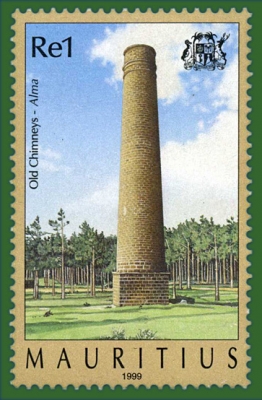
Number by catalogue: Michel: 883 Yvert: 930 Scott: 886
Perforation: Comb Perforation type: 14 ¼x14 ¼
Subject:
1 Mauritian rupee.
Chimney Alma
-
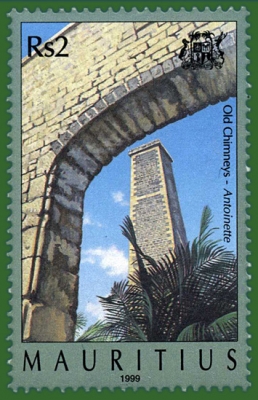
Number by catalogue: Michel: 884 Yvert: 931 Scott: 887
Perforation type: 14 ¼x14 ¼
Subject:
2 Mauritian rupees.
Chimney Antoinette
-
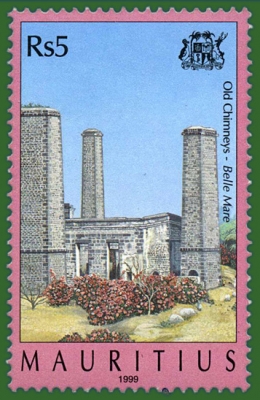
Number by catalogue: Michel: 885 Yvert: 932 Scott: 888
Perforation type: 14 ¼x14 ¼
Subject:
5 Mauritian rupees.
Chimney Belle Mare
-
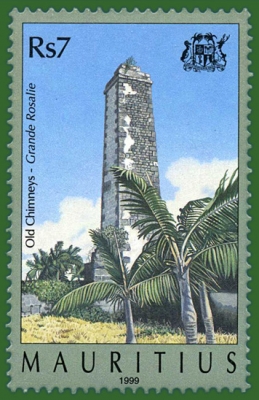
Number by catalogue: Michel: 886 Yvert: 933 Scott: 889
Perforation type: 14 ¼x14 ¼
Subject:
7 Mauritian rupees.
Chimney Rosaliе
-
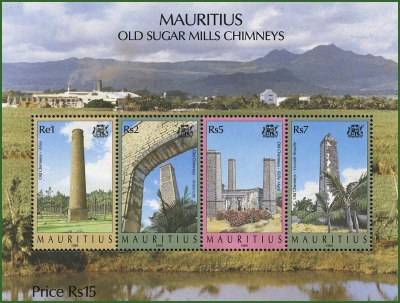
Number by catalogue: Michel: BL21 Yvert: BF21 Scott: 889a
Perforation: Comb Perforation type: 14 ¼x14 ¼
Subject:
4 stamps of the main issue set against the mauritian landscape with a modern sugar factory.
Additional:
The first agricultural plant of economic importance to be introduced to Mauritius was sugar cane. From 1639 it was used on an artisanal basis by Dutch settlers primarily to produce an alcoholic beverage called arrack. Arrack is made of molasses, which is produced as a by-product when making sugar. The first organized sugar mill on the island appears to have been that of the Wilhems brothers at the center of the island, under Governor Issac Johannes Lamotius (1677-1692). Under Governor Roelof Deodati (1692 -1703), the production of sugar was successfully extended with the arrival of a surgeon, Jean Boekelberg on board the ship Standvastighied. Boekelberg had studied the sugar industry in Surinam and successfully used his knowledge within this fledgling industry.
Bertrand-François Mahé de La Bourdonnais (1737 -1745) was the first French Governor to make a long-lasting impact on Mauritius and is considered by some as the real founder of Mauritius as a French colony. He encouraged the growth of sugar cane and created the infrastructure necessary for its extension throughout the colony. He imported the necessary new technology to make the industry more efficient. During his governorship, the first modern sugar mills for the era were commissioned. These were the Rosalie-Villebague mill in Pamplemousse in 1745 and the mill at Grande Riviere Sud Est in Ferney.
British Mauritius, with Robert Townsend Farquhar as the first governor, brought about rapid social and economic changes. One of the most important was the abolition of slavery on 1 February 1835. The planters received a compensation of two million pounds sterling for the loss of their slaves, who had been imported from Africa and Madagascar during the French occupation. The number of Mauritius Sugar Mills grew, as did their efficiency with the introduction of new technology, as competition became fierce. This led to the consolidation of the entire industry after 1860 when the number of operating mills decreased from 296 units to 30 in 1947.
Between 1812 and 1949, the production of sugar factories in Mauritius increased from 467 tons to over 400,000 tons per year, despite cyclones and the accidental introduction of the Chilo sacchariphagus sacchariphagus parasite from Java in 1850, which destroyed that year's crop.
By the beginning of the 21st century, 11 operating sugar factories remained on the island.
From the old factories on the island, only chimneys remained, in places surrounded by dilapidated walls, arches and gates. Many of them are of great interest among tourists, they are protected as architectural monuments, some are part of the Museum of Sugar Mills and Cane Sugar. On a one and a half hour guided tour by the museum, visitors walk through the cane plantation, museum premises and modern factory, where they are told historical facts and are shown the modern production processes for the manufacture of sugar and cane by-products. The excursion ends with a tasting of sugar products and various types of rum.
__________
This information was based on information from Wikipedia
Size (of sheet, booklet) mm: 132x100
Old Sugar Mill Chimneys
Mauritius 1999.09.17
In issue: Stamp(s): 4 Souvenir sheet(s): 1
Printing: offset